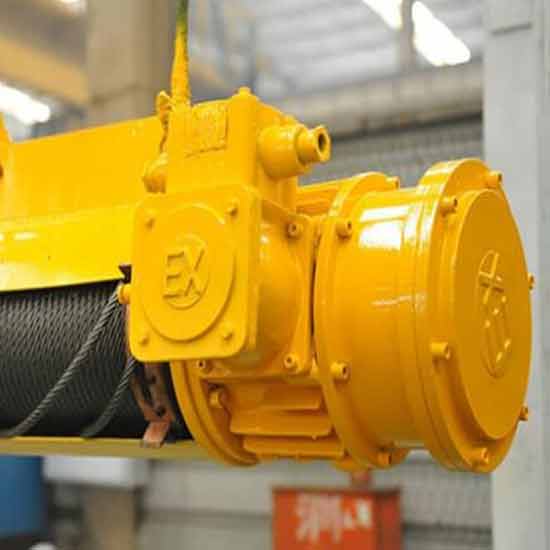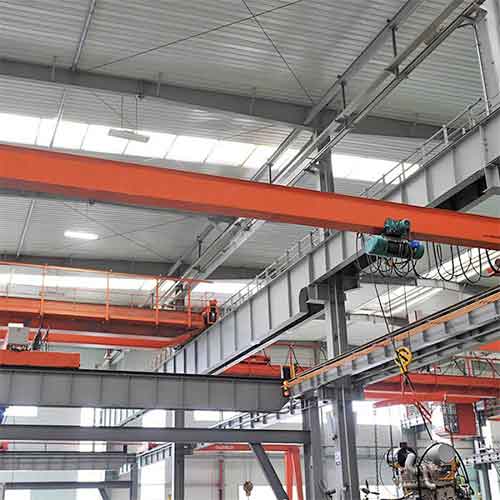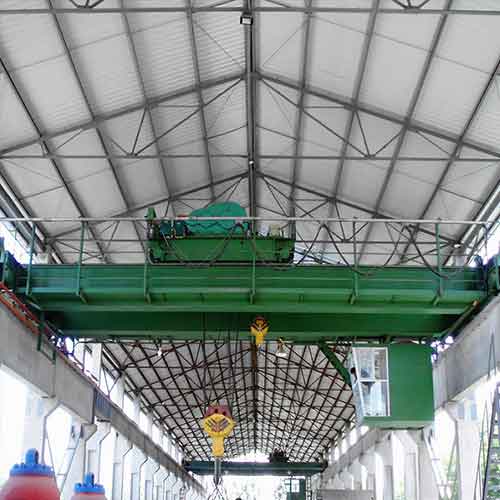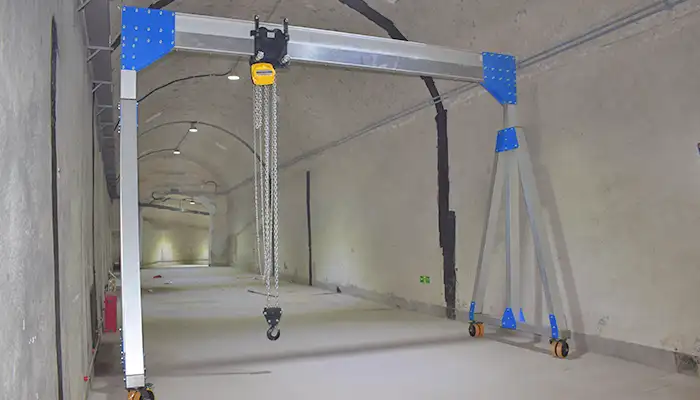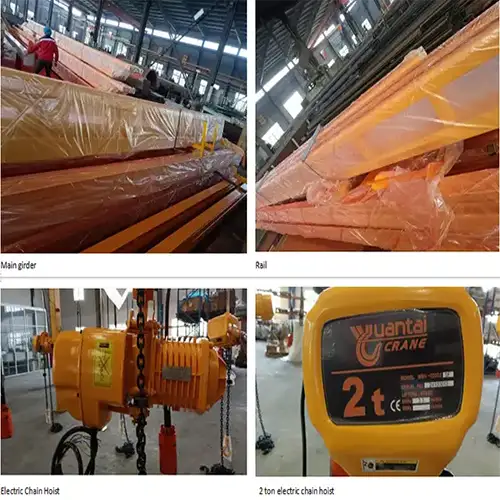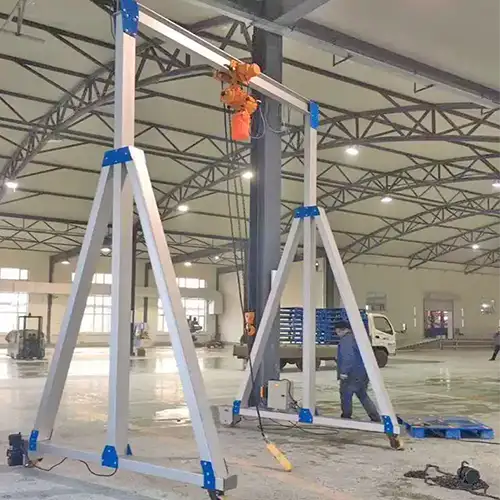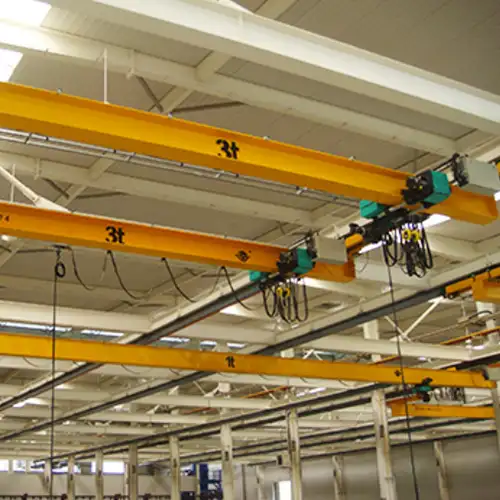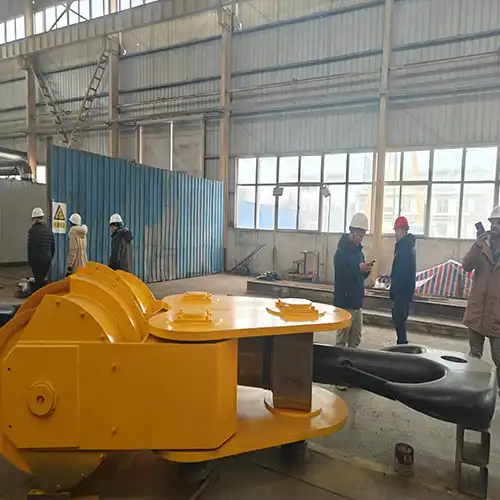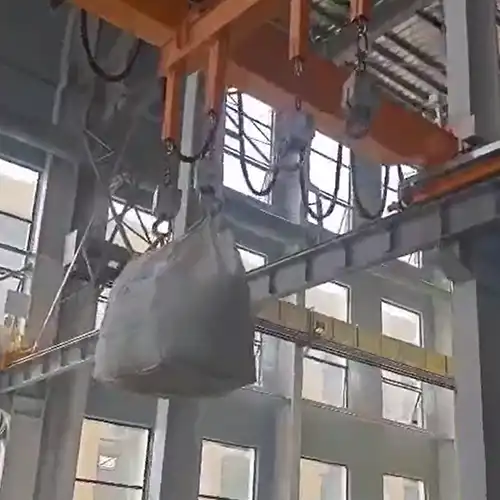Explosion-Proof Cranes in Kuwait's Petrochemical Industry
Explosion proof cranes for sale. All types of explosion proof overhead crane, with single girder crane design & double girder crane design for sale Kuwait.
Category: Kuwait
Your Trusted Overhead Crane Manufacturer & Supplier
Explosion-Proof Cranes in Kuwait's Petrochemical Industry
Explosion proof cranes for sale. All types of explosion proof overhead crane, with single girder crane design & double girder crane design for sale Kuwait.
Explosion-Proof Cranes in Kuwait's Petrochemical Industry
Kuwait's petrochemical industry stands as a cornerstone of its economy, contributing significantly to its growth and development. The sector encompasses the production of various chemicals and derivatives derived from petroleum. It plays a pivotal role in the country's economic diversification and serves as a vital component of its industrial landscape.
Within Kuwait's petrochemical sector, safety and precision hold paramount importance. Handling hazardous materials and substances is a routine aspect of operations, making safety protocols and equipment vital. Explosion-proof cranes emerge as a critical asset in this environment, ensuring the safe and efficient handling of materials in potentially hazardous zones.
In the petrochemical industry, maintaining precise operations while ensuring utmost safety is crucial. Precision is necessary for handling delicate chemical processes, while safety protocols are non-negotiable due to the presence of combustible and hazardous materials. Explosion-proof cranes, engineered to function in such sensitive environments, play an integral role in upholding these dual necessities of precision and safety.
Explosion-proof cranes are specially designed to meet the stringent safety standards required in hazardous areas. These cranes are equipped with features that prevent the risk of ignition in potentially explosive atmospheres, safeguarding both personnel and assets.
Overview of Explosion-Proof Cranes
Explosion-proof cranes are specialized lifting equipment designed explicitly for operation in hazardous or potentially explosive environments, commonly found in petrochemical plants and other industrial settings dealing with flammable gases, vapors, or combustible dust.
These cranes are engineered with several key features:
- Sealed Components: Explosion-proof cranes are equipped with sealed motors, electrical systems, and enclosures to prevent the entry of flammable substances and avoid sparking or igniting hazardous atmospheres.
- Robust Construction: They are constructed with materials resistant to corrosion and designed to withstand harsh environments while ensuring durability and reliability.
- Safety Measures: These cranes incorporate safety features such as overload protection, emergency stop systems, and flameproof enclosures to minimize the risk of accidents and ensure safe operations.
Classification and Standards for Hazardous Environments
Explosion-proof cranes adhere to stringent classifications and standards based on the potential risk levels of hazardous environments. These classifications follow codes and regulations outlined by organizations like ATEX, IECEx, or NEC, categorizing hazardous zones into distinct classes and divisions based on the presence of flammable substances.
Explosion-Proof Crane Classifications and Standards
Explosion-proof cranes adhere to specific classifications and standards to operate safely in hazardous environments where flammable substances are present:
Zone Classification
Definition: Hazardous zones are categorized into different zones based on the probability and duration of the presence of flammable substances.
Examples: Zones may include Zone 0 (where explosive atmospheres are present continuously or for long periods), Zone 1 (where explosive atmospheres are likely to occur occasionally), and Zone 2 (where explosive atmospheres are unlikely to occur or exist for a short time).
Importance of Precision and Safety
In hazardous zones, precision and safety are critical factors in material handling operations:
Precision Handling: Operations in hazardous environments demand absolute precision to prevent accidents and environmental hazards. Explosion-proof cranes are specifically designed to provide accurate and controlled lifting and movement of materials in such sensitive areas.
Safety Standards Compliance: Explosion-proof cranes play a pivotal role in adhering to safety standards, ensuring that the equipment operates safely within hazardous zones. These cranes are built with robust safety features to mitigate the risk of igniting flammable materials, contributing to a safer working environment.
Explosion-proof cranes are engineered to maintain safety standards while ensuring precise and efficient material handling within hazardous areas, promoting operational safety and minimizing the risk of accidents or environmental damage.
Applications of Explosion Proof Cranes
Handling Hazardous Chemicals and Substances
Absolutely, the safe handling of hazardous chemicals and substances in petrochemical plants is a critical concern. Here's a more detailed expansion on the importance of safe material handling and the prevention of environmental hazards:
Importance of Safe Material Handling
Petrochemical Plants and Hazardous Materials
Petrochemical plants often deal with a wide range of hazardous chemicals and substances essential for various processes. Ensuring the safe and precise handling of these materials is of utmost importance to prevent accidents, protect personnel, and maintain the integrity of the environment.
Role of Explosion-Proof Cranes
Controlled Movement: Explosion-proof cranes play a pivotal role in these environments by providing controlled and precise movement of hazardous materials. Their specialized design allows for meticulous lifting, transferring, and positioning of these substances, minimizing the risks associated with manual handling.
Risk Mitigation: With their robust construction and safety features, explosion-proof cranes reduce the possibility of accidents during material handling operations. These cranes are engineered to prevent sparks, arcs, or heat generation that could potentially trigger fires or explosions in areas with flammable substances.
Prevention of Environmental Hazards
Mitigating Environmental Risks
Accident Prevention: By utilizing explosion-proof cranes specifically designed for hazardous environments, the risk of accidental spills or leaks during material handling is significantly mitigated. These cranes ensure that materials are handled with precision and care, minimizing the potential for incidents that could harm the environment.
Environmental Protection: The use of explosion-proof cranes contributes to environmental protection by preventing hazardous material spills. This proactive approach helps safeguard not only the immediate surroundings but also the broader ecosystem from potential contamination or damage due to accidental releases.
In conclusion, the deployment of explosion-proof cranes in petrochemical plants is crucial for safe material handling. These specialized cranes are pivotal in mitigating risks associated with hazardous substances, ensuring precise movement, and significantly reducing the potential for environmental hazards stemming from mishandling or accidents.
Ensuring Safety Protocols in Sensitive Areas
Design Features for Hazardous Zones
Purposeful Engineering of Explosion-Proof Cranes
Sealed Enclosures: These cranes incorporate sealed enclosures to prevent the ingress of hazardous elements. The enclosures effectively safeguard critical components, ensuring they remain isolated from potentially flammable substances present in the environment.
- Spark-Resistant Components: Components within explosion-proof cranes are carefully selected and engineered to be spark-resistant. This design feature significantly reduces the likelihood of sparks or arcs that could ignite flammable materials, making these cranes suitable for hazardous atmospheres.
- Flameproof Equipment: The equipment used in these cranes is flameproof, which means it is constructed to contain any explosion within its enclosure, preventing it from propagating outside and causing further damage.
Maintenance of Secure Workspaces
Strict Adherence to Safety Protocols: By utilizing explosion-proof cranes, industrial facilities can strictly adhere to safety protocols in sensitive areas. These cranes meet stringent industry standards and regulatory requirements, ensuring compliance with safety guidelines set for hazardous zones.
- Minimizing Risk: The specialized construction and safety features of explosion-proof cranes minimize the risk of accidents or incidents in potentially explosive environments. This, in turn, creates a safer working environment for personnel and surrounding assets.
- Enhanced Safety Measures: These cranes contribute to creating secure workspaces by providing an added layer of safety due to their robust design, reducing the likelihood of hazards associated with equipment failures or ignition sources.
In summary, explosion-proof cranes are meticulously designed with features specifically tailored for hazardous zones. These design elements, including sealed enclosures, spark-resistant components, and flameproof equipment, play a crucial role in maintaining secure workspaces in sensitive areas, ensuring the safety of personnel and assets operating within these environments.
Compliance and Safety Standards
Adherence to Hazardous Area Classifications
Explosion-proof cranes are meticulously designed to conform to specific hazardous area classifications, such as Zone 0, Zone 1, Zone 2, or Division 1, Division These classifications delineate areas based on the likelihood and duration of the presence of explosive atmospheres or hazardous substances. Explosion-proof cranes are purpose-built to operate safely within these classified zones, ensuring the prevention of potential ignition sources.
Stringent Safety Features in Crane Design
The design of explosion-proof cranes integrates a host of stringent safety features aimed at preventing sparks or sources of ignition in volatile environments. These features include:
- Sealed Enclosures: Components are sealed to prevent the entry of flammable gases or dust, minimizing the risk of ignition.
- Explosion-Proof Motors: Specialized motors are used that eliminate sparks or overheating, reducing the risk of explosions.
- Overload Protection Systems: Built-in mechanisms ensure immediate shutdown in case of overloading, averting potential hazards.
Regulations and Certifications for Petrochemical Environments
Operating within petrochemical environments mandates strict adherence to safety regulations and certifications. Organizations such as ATEX (Appareils destinés à être utilisés en ATmosphères EXplosibles) and NEC (National Electrical Code) establish stringent safety standards and certification processes for explosion-proof equipment. Compliance with these regulations is essential, ensuring the safety and efficacy of explosion-proof cranes deployed in petrochemical environments.
Advantages and Benefits of Explosion Proof Cranes
Safety Contributions in Petrochemical Operations
Explosion-proof cranes significantly contribute to enhancing safety levels in petrochemical operations. Their specialized design and adherence to stringent safety standards ensure the prevention of potential ignition sources in hazardous environments. By eliminating the risk of sparking or overheating, these cranes play a pivotal role in minimizing the probability of accidents or explosions, safeguarding both personnel and critical infrastructure.
Precision and Efficiency in Handling Hazardous Loads
In petrochemical settings, the need for precise and efficient handling of hazardous loads is paramount. Explosion-proof cranes offer precise control and maneuverability, allowing for the meticulous lifting, positioning, and transfer of volatile materials. Their advanced technology enables operators to perform these tasks with accuracy and efficiency, minimizing the potential for mishaps and ensuring the integrity of operations.
Case Studies and Success Stories in Petrochemical Settings
Real-life case studies and success stories demonstrate the practical applications and effectiveness of explosion-proof cranes in petrochemical environments. Highlighting instances where these cranes have contributed to improved safety, operational efficiency, and successful handling of hazardous materials can serve as valuable examples of their efficacy.
Challenges and Mitigation Strategies
Addressing Safety Concerns and Risk Factors
Operating in petrochemical environments presents inherent safety challenges. Mitigating these concerns requires a comprehensive approach that involves meticulous planning, employee training, and adherence to strict safety protocols. Explosion-proof cranes aid in mitigating these concerns, but additional measures like risk assessments and hazard analyses are vital to preemptively identify and address potential safety risks.
Ensuring Maintenance and Regular Inspections
Regular maintenance and inspections are imperative for the seamless operation of explosion-proof cranes in petrochemical settings. Establishing a robust maintenance schedule and adhering to manufacturer-recommended service intervals are critical. Routine inspections ensure that crane components remain in optimal condition, reducing the risk of malfunctions and enhancing overall safety.
Regulatory Compliance and Continuous Adaptation
Staying abreast of evolving safety regulations and standards is crucial. Regulatory frameworks governing petrochemical environments often undergo updates and revisions. Continuous adaptation to these changes is necessary to ensure that explosion-proof cranes comply with the latest safety requirements and industry best practices.
Technological Advancements and Future Trends
Innovations in Explosion-Proof Crane Technology
Continuous advancements in technology pave the way for innovative enhancements in explosion-proof crane design. These may include:
- Advanced Materials: Incorporation of cutting-edge materials resistant to corrosion and sparking.
- Smart Automation: Integration of smart sensors and automation for enhanced precision and operational efficiency.
- Remote Monitoring: Utilization of remote monitoring systems for real-time diagnostics and predictive maintenance.
Anticipated Developments for Enhanced Safety and Precision
Future developments in explosion-proof crane technology are expected to focus on:
- Enhanced Safety Features: Further improvements in safety measures to minimize risks and enhance safety levels.
- Precision and Control: Continued advancements in crane controls and precision technology for more accurate and controlled operations in hazardous zones.
- Efficiency Upgrades: Innovations aimed at increasing operational efficiency without compromising safety.
Explosion-proof cranes stand as indispensable assets within the petrochemical industry, serving as a cornerstone in ensuring precision, safety, and operational efficiency. Their specialized design and adherence to stringent safety standards make them invaluable in hazardous environments.
Throughout this exploration, the critical role of explosion-proof cranes in enhancing precision and safety within petrochemical operations has been evident. These cranes contribute significantly to mitigating risks, preventing accidents, and maintaining secure workspaces in sensitive areas.
As the petrochemical industry continues to evolve, adherence to safety standards and continuous enhancement of safety measures remain imperative. Encouraging adherence to evolving safety regulations, periodic training, and fostering a culture of safety consciousness among personnel are key recommendations to further bolster safety in petrochemical environments.
Main Projects
Related Products
Supplied three grab bucket crane kits to Indonesia, enhancing garbage handling efficiency with high load capacity and reliable performance.
Free consultation to Confirm Parameters & Specifications and Get
Latest Crane Price & Crane Rate.
- Types of overhead cranes : _______?
- Optional: Overhead travelling crane, goliath gantry crane,Slewing jib crane, Single girder or double girder crane,small portable crane or kbk crane, etc.
- Capacity of overhead crane: _______?
- Optional: 0.25ton, 0.5 ton, 1 ton, 2 ton, 3ton, 5 ton, 10 ton,15ton, 20ton, 25 ton, 30ton,35ton, up to 550ton, etc.
- Crane span & lifting height : _______?
- Crane travelling length : _____?
- Control of overhead crane:_______?
- Optional: pendant/ remote/cabin control
- Voltage supply of overhead crane:_____?
- Eg,: 380V50/60HZ,3Phase or others,etc.
- Application/usage of crane:_______?
- Eg,: Steel mill, ,injection mold, cement,stone, concrete,granite, general manufacturing, etc.
Just leave a message via the contact form and our hoist and crane engineer will contact you with in 24working hours.
Get In Touch
